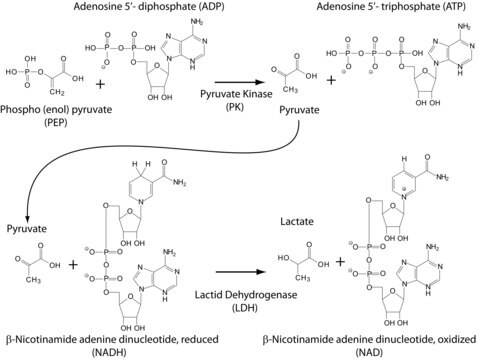C1744
Phosphoenolpyruvate carboxylase microbial
≥5.0 unit/mg solid
Sinónimos:
PEPC
Iniciar sesiónpara Ver la Fijación de precios por contrato y de la organización
About This Item
Productos recomendados
form
lyophilized powder
Quality Level
specific activity
≥5.0 unit/mg solid
mol wt
~390 kDa
storage temp.
−20°C
Application
Phosphoenolpyruvate carboxylase (PEPC) is an enzyme useful for enzymatic determination of carbon dioxide when coupled with malate dehydrogenase in clinical analysis. PEPC is also used to study carbon assimilation, post-translational regulation and allosteric regulation in various plants .
Biochem/physiol Actions
Phosphoenolpyruvate carboxylase (PEPC) catalyzes the addition of bicarbonate to phosphoenolpyruvate (PEP) to form the four-carbon compound oxaloacetate and inorganic phosphate . In CAM and C4 plants, PEPC catalyzes the photosynthetic assimilation of CO2 into an organic acid. PEPC is activated by glucose-6-phosphate and is inhibited by malate and aspartate. PEPC comprises about 0.5-2% of the soluble protein in alfalfa and soybean nodules .
Unit Definition
One unit causes the oxidation of one micromole of NADH per minute at pH 8.0 at 30°C.
Physical form
White amorphous lyophilized powder containing BSA and sugar alchohols as stabilizers.
signalword
Danger
hcodes
pcodes
Hazard Classifications
Resp. Sens. 1
Storage Class
11 - Combustible Solids
wgk_germany
WGK 1
flash_point_f
Not applicable
flash_point_c
Not applicable
Certificados de análisis (COA)
Busque Certificados de análisis (COA) introduciendo el número de lote del producto. Los números de lote se encuentran en la etiqueta del producto después de las palabras «Lot» o «Batch»
¿Ya tiene este producto?
Encuentre la documentación para los productos que ha comprado recientemente en la Biblioteca de documentos.
Los clientes también vieron
Mika Nomura et al.
Plant & cell physiology, 47(5), 613-621 (2006-03-10)
Phosphoenolpyruvate carboxylase (PEPC, EC 4.1.1.31) is believed to play a significant role in supporting nitrogen fixation via anaplerotic CO2 fixation for recycling carbon in nodules. Using the antisense technique, we decreased the expression levels of the nodule-enhanced PEPC gene (Ljpepc1)
Masataka Wakayama et al.
Journal of plant research, 126(2), 233-241 (2012-10-18)
The C(4) grass Arundinella hirta exhibits a unique C(4) anatomy, with isolated Kranz cells (distinctive cells) and C(4)-type expression of photosynthetic enzymes in the leaf sheath and stem as well as in the leaf blade. The border zones between these
Patrizia De Nisi et al.
Plant physiology and biochemistry : PPB, 57, 168-174 (2012-06-19)
The regulation exerted by the Fe status in the plant on Fe deficiency responses was investigated in Cucumis sativus L. roots at both biochemical and molecular levels. Besides the two activities strictly correlated with Fe deficiency response, those of the
Jitender Singh et al.
Gene, 500(2), 224-231 (2012-06-20)
Phosphoenolpyruvate carboxylase is an ubiquitous cytosolic enzyme that catalyzes the ß-carboxylation of phosphoenolpyruvate (PEP) and is encoded by multigene family in plants. It plays an important role in carbon economy of plants by assimilating CO2 into organic acids for subsequent
Judith Katharina Paulus et al.
Nature communications, 4, 1518-1518 (2013-02-28)
The C4-photosynthetic carbon cycle is an elaborated addition to the classical C3-photosynthetic pathway, which improves solar conversion efficiency. The key enzyme in this pathway, phosphoenolpyruvate carboxylase, has evolved from an ancestral non-photosynthetic C3 phosphoenolpyruvate carboxylase. During evolution, C4 phosphoenolpyruvate carboxylase
Nuestro equipo de científicos tiene experiencia en todas las áreas de investigación: Ciencias de la vida, Ciencia de los materiales, Síntesis química, Cromatografía, Analítica y muchas otras.
Póngase en contacto con el Servicio técnico









